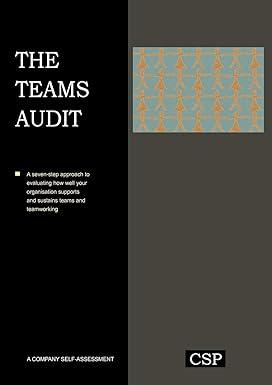Answered step by step
Verified Expert Solution
Question
1 Approved Answer
Case Studies 173 Lase studies 173 JOB OFFERS Robin Pinelli is considering three job offers. In trying to decide which to accept, Robin has concluded
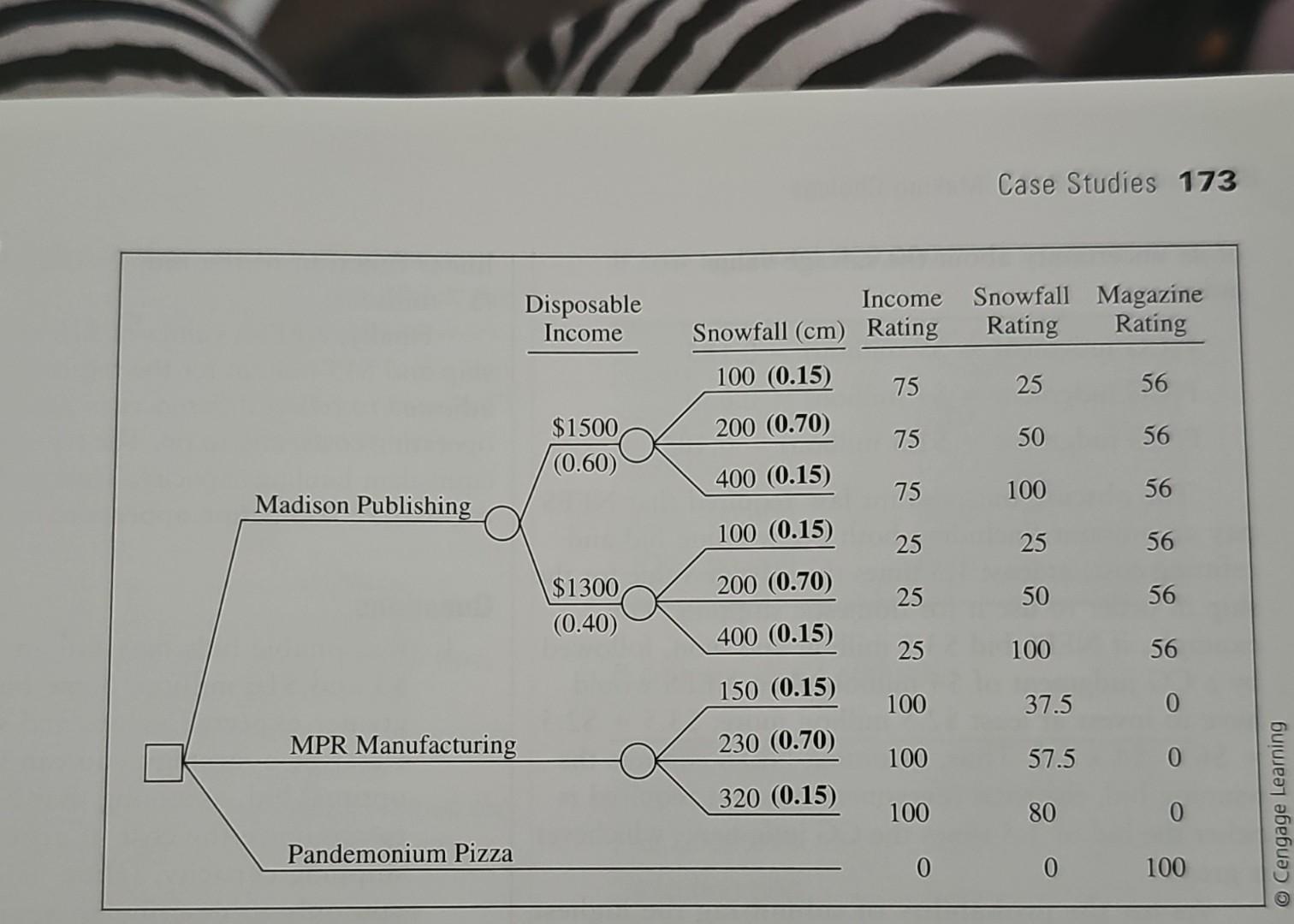
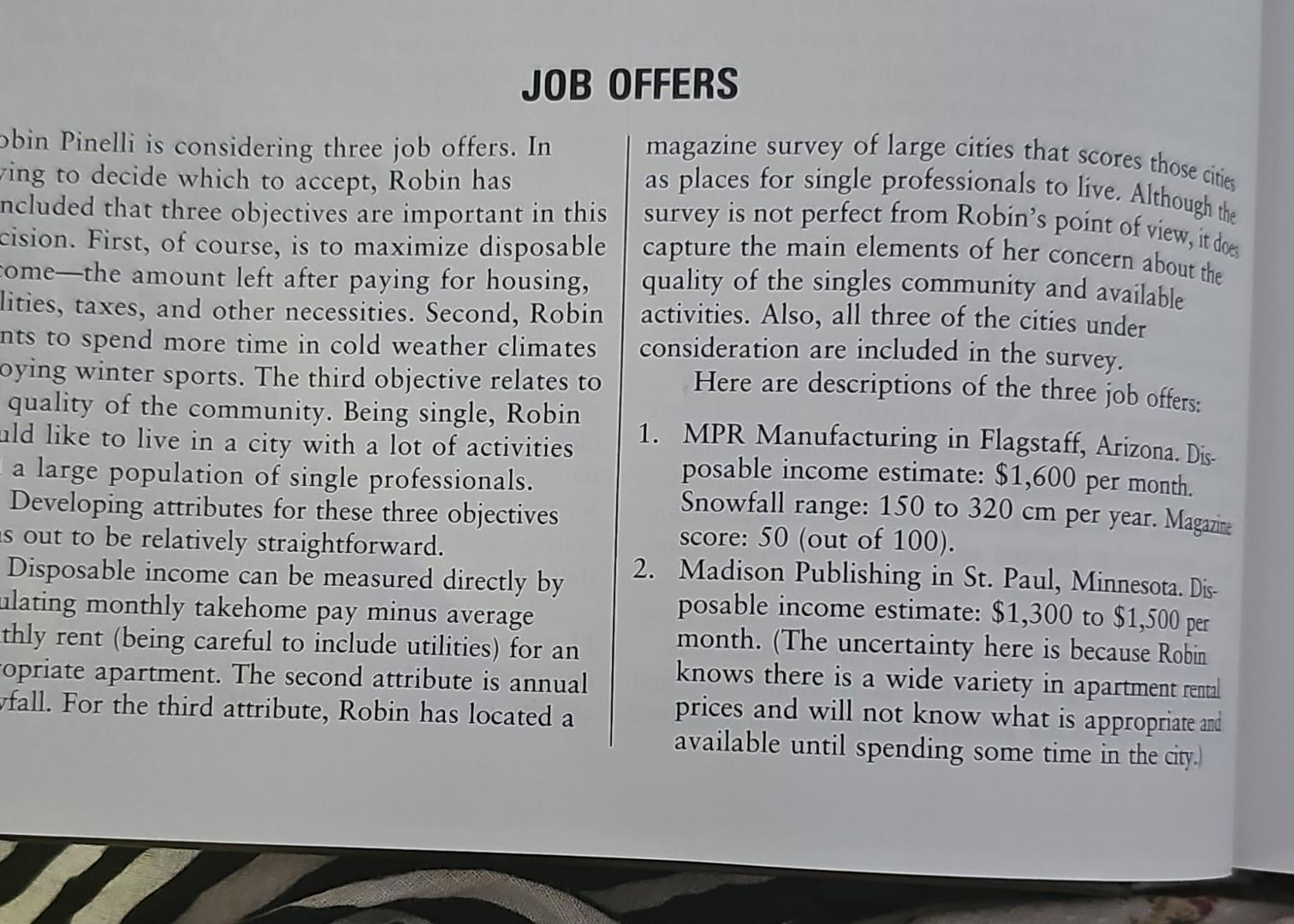
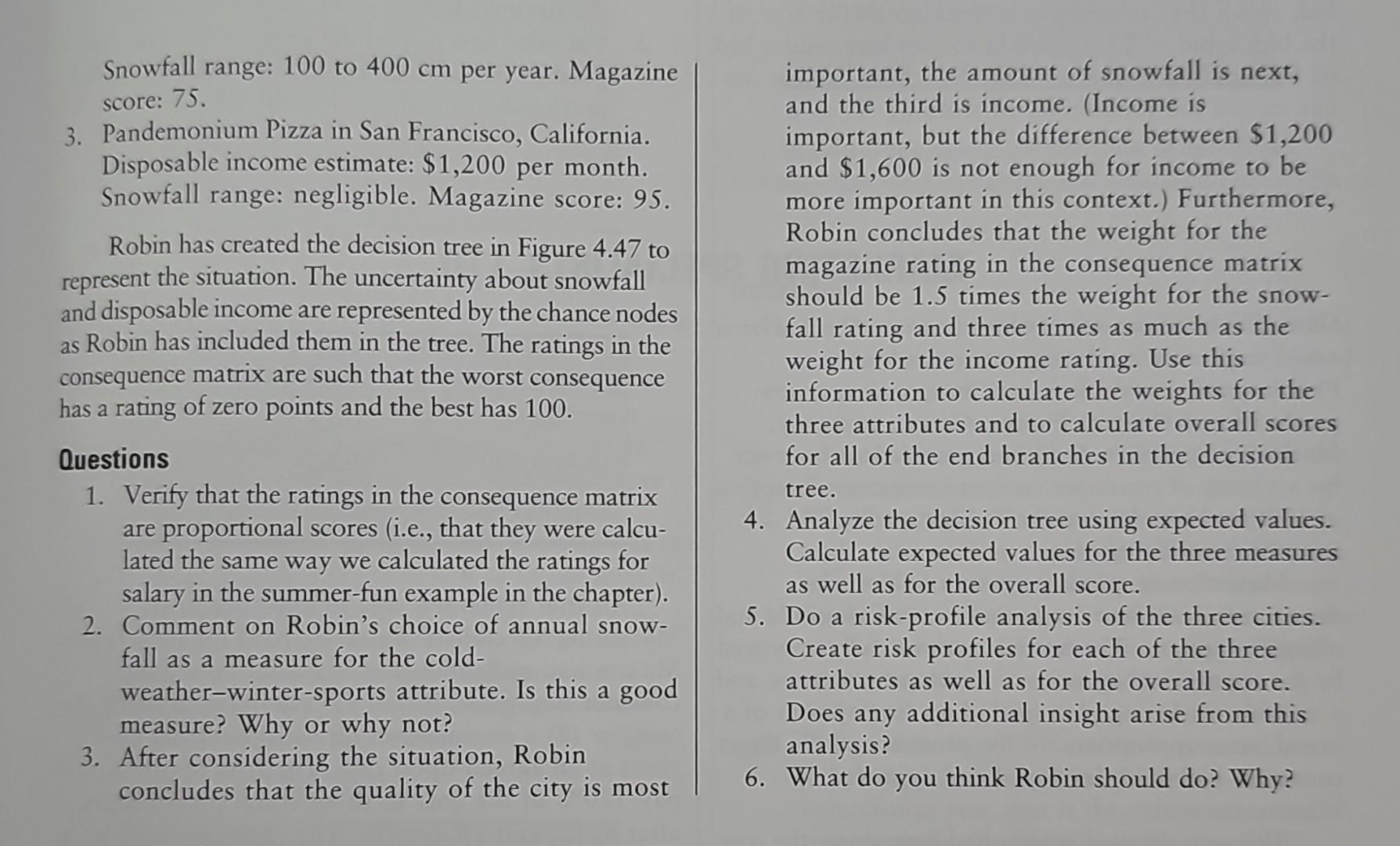
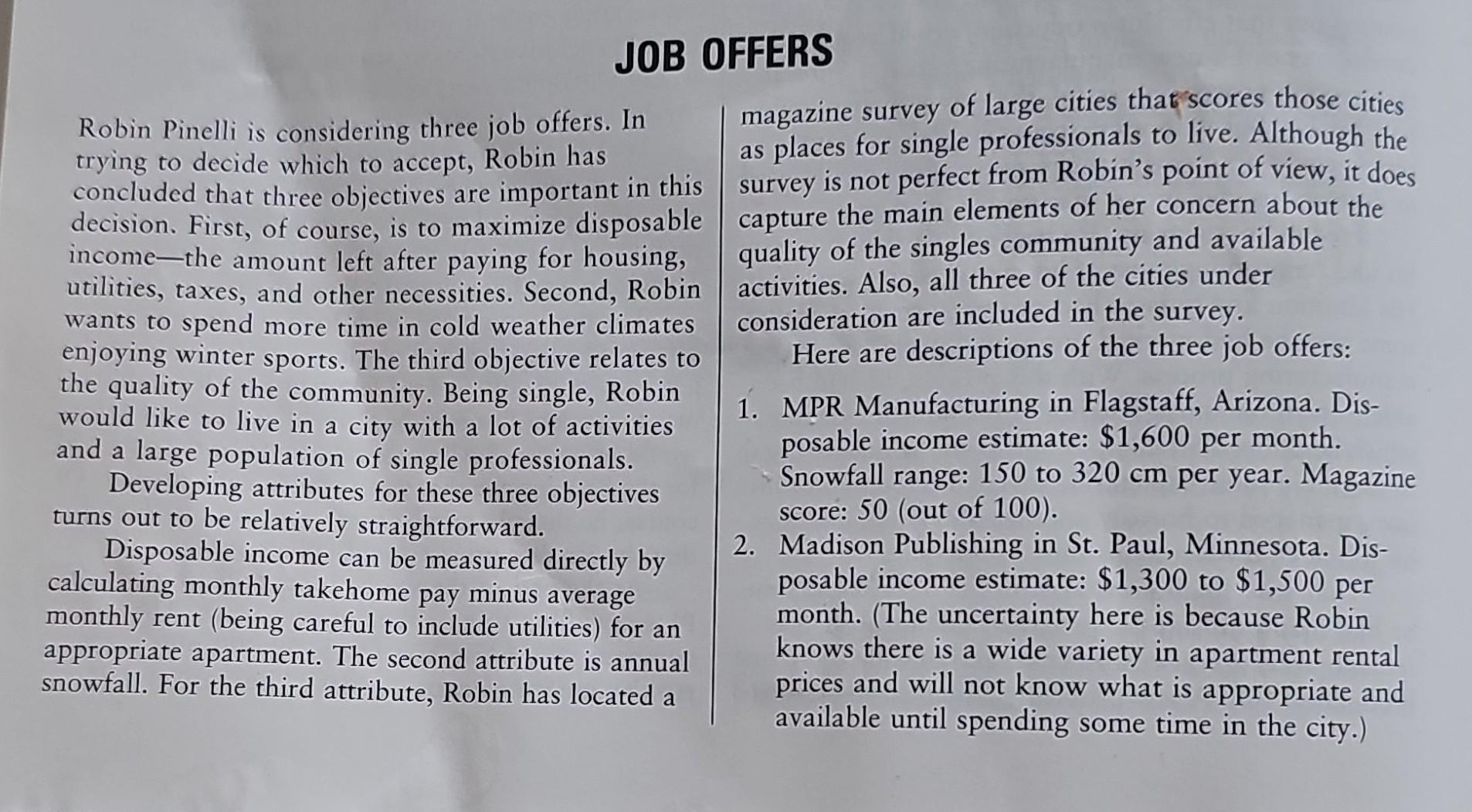
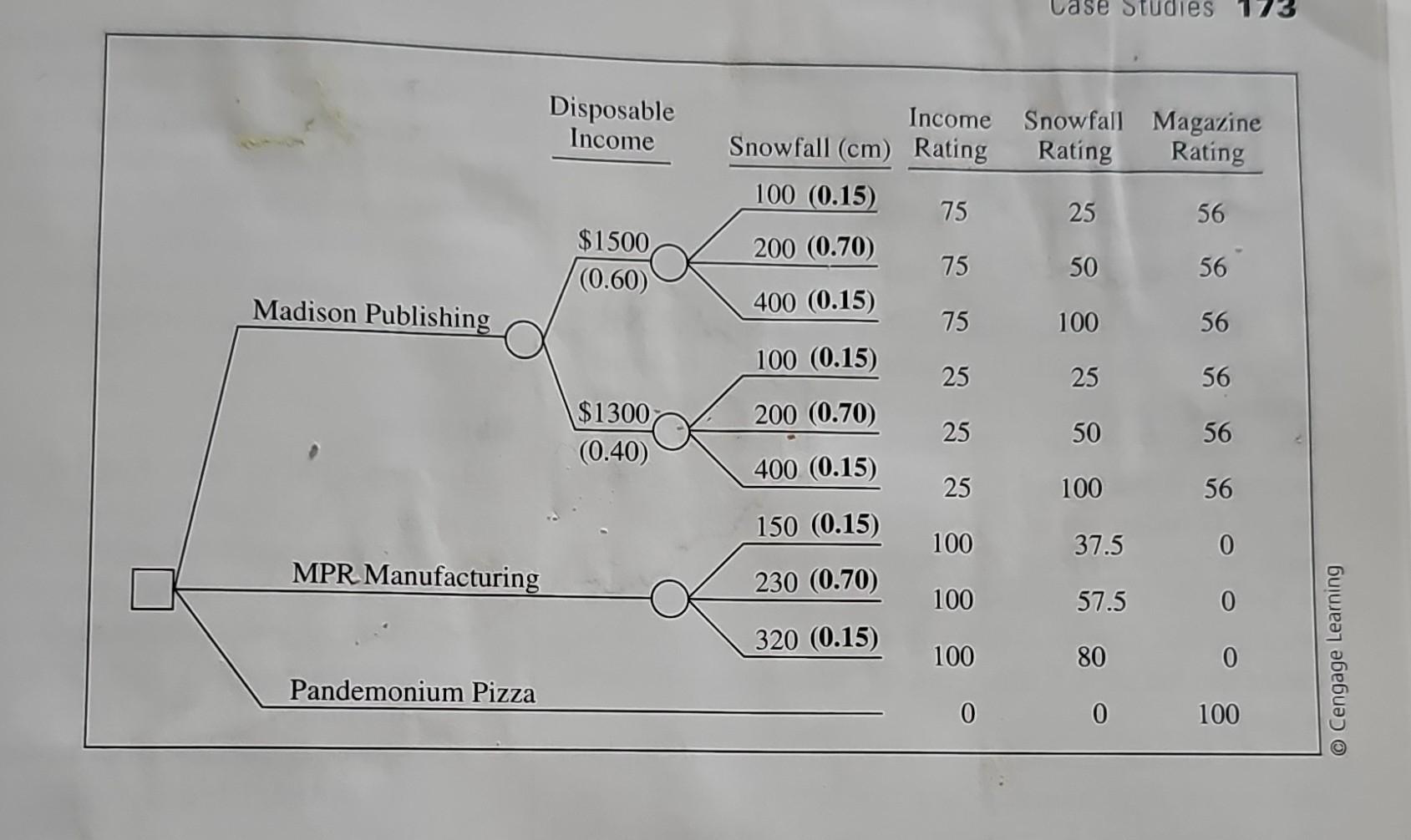
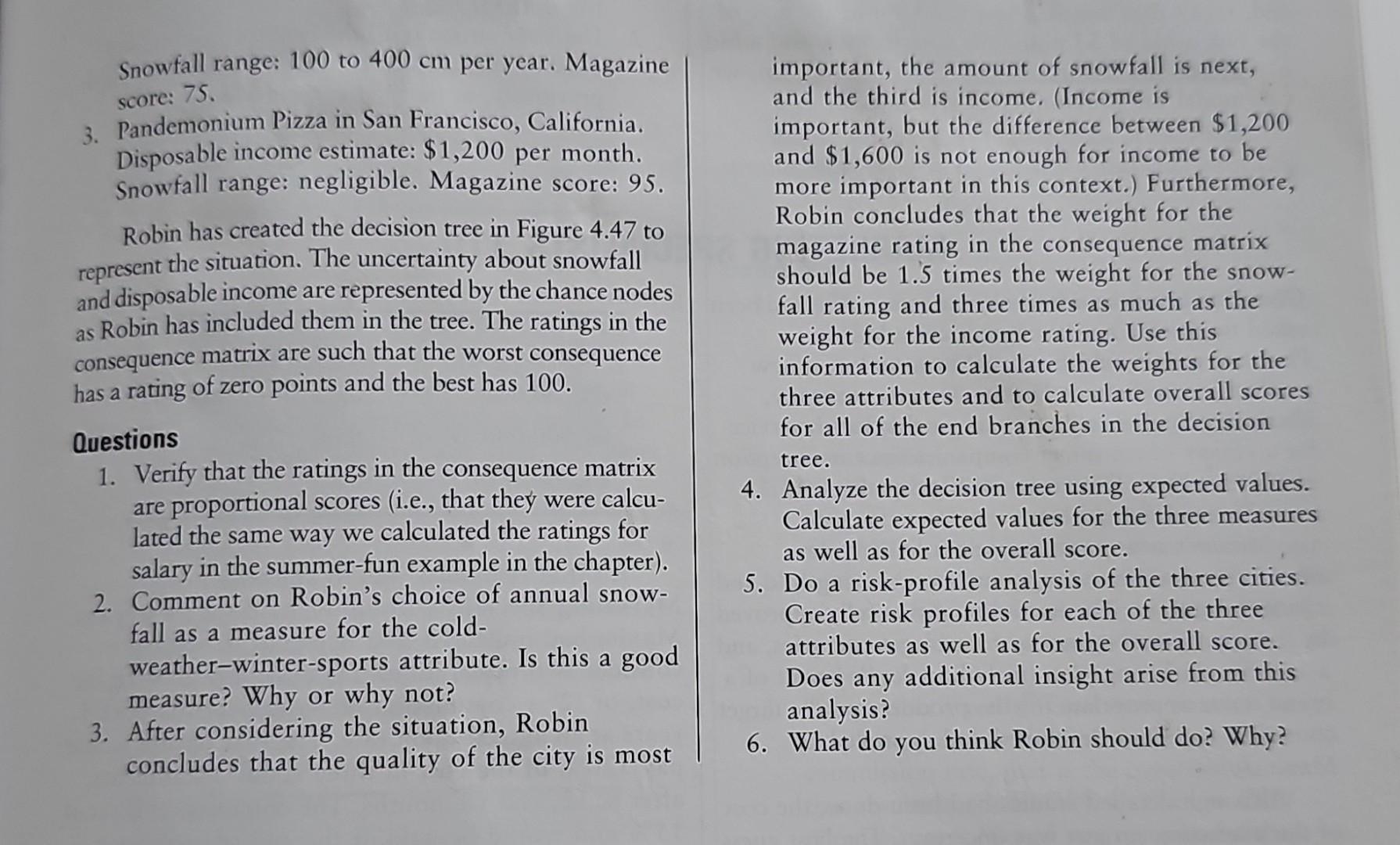
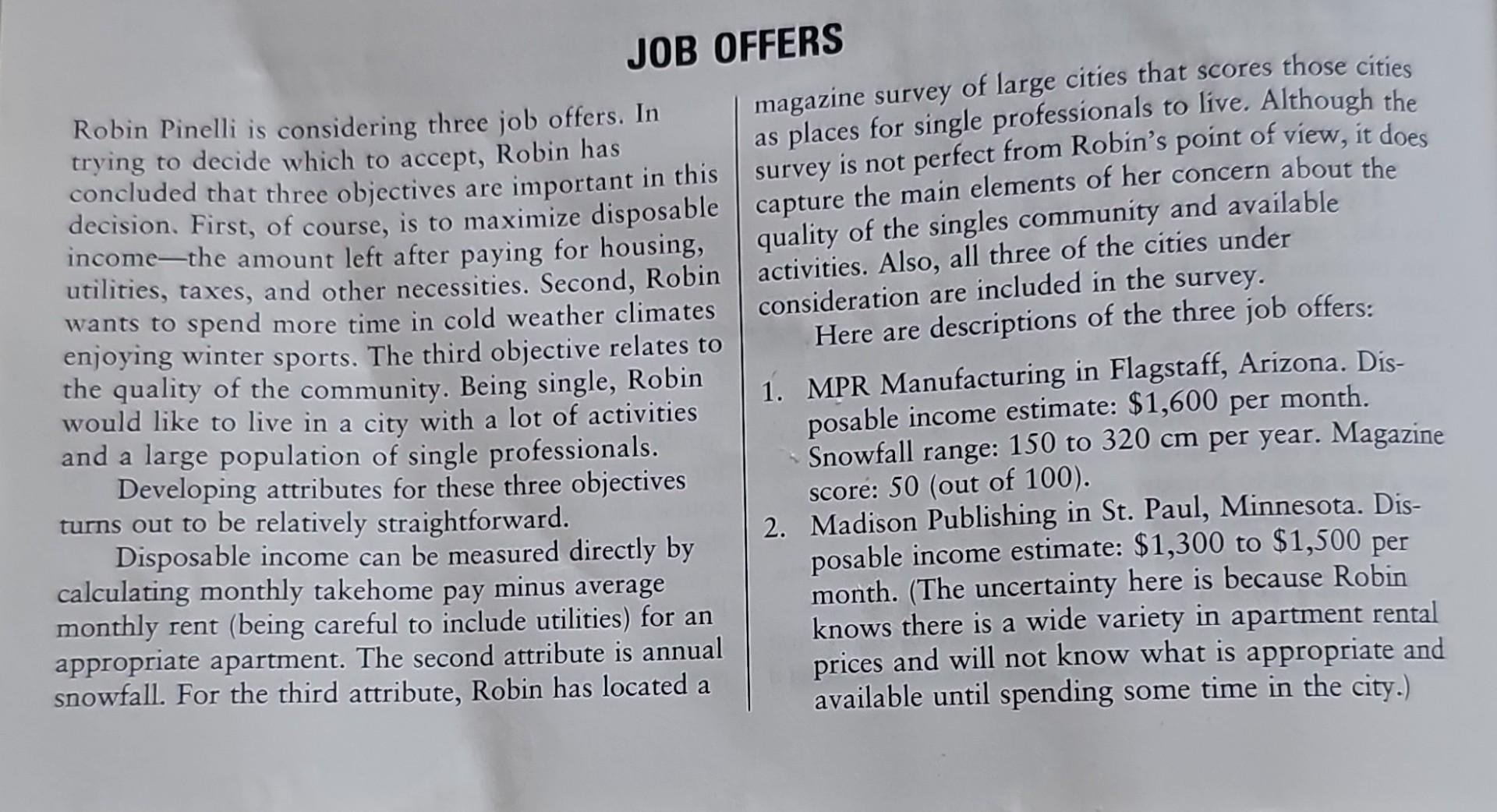
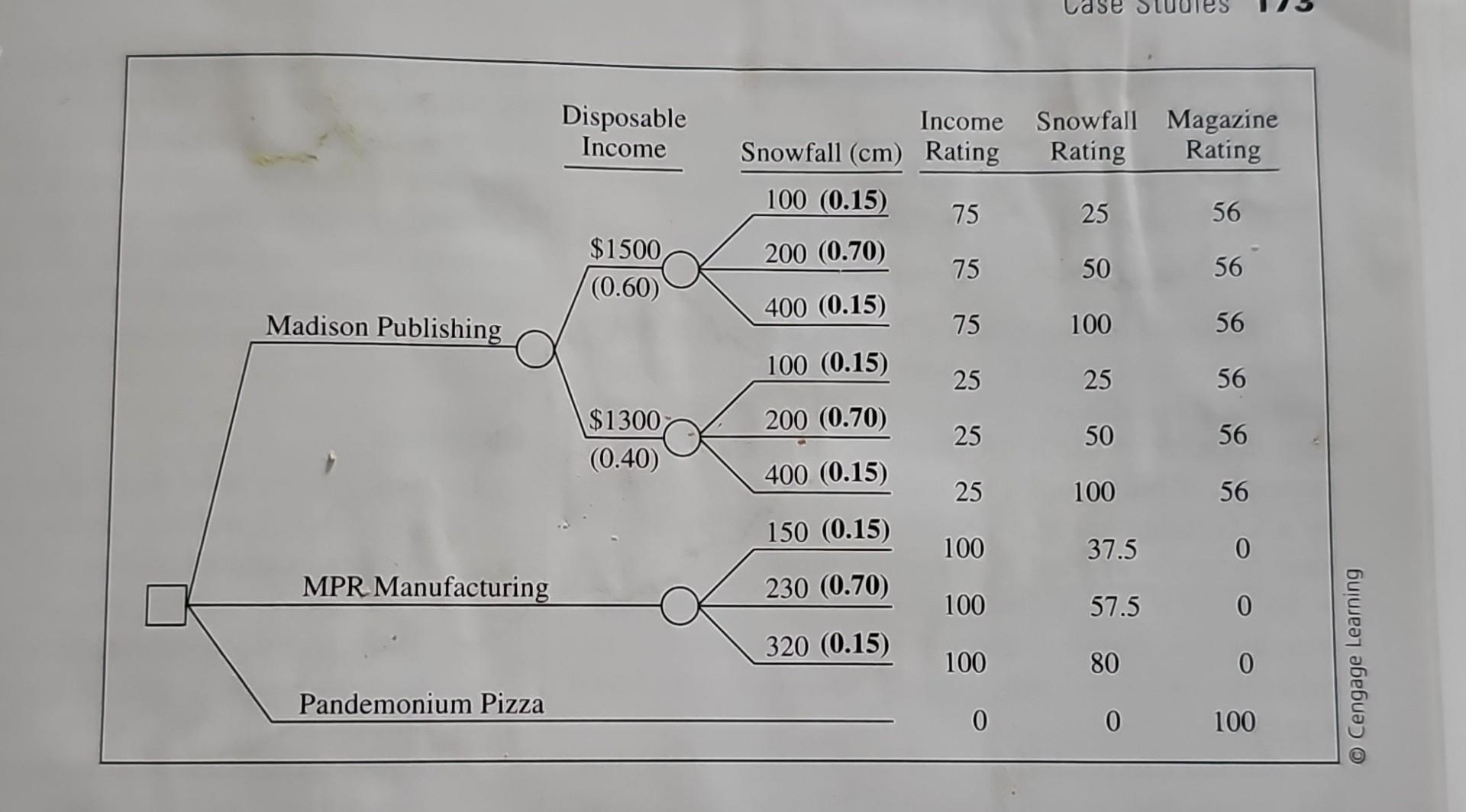
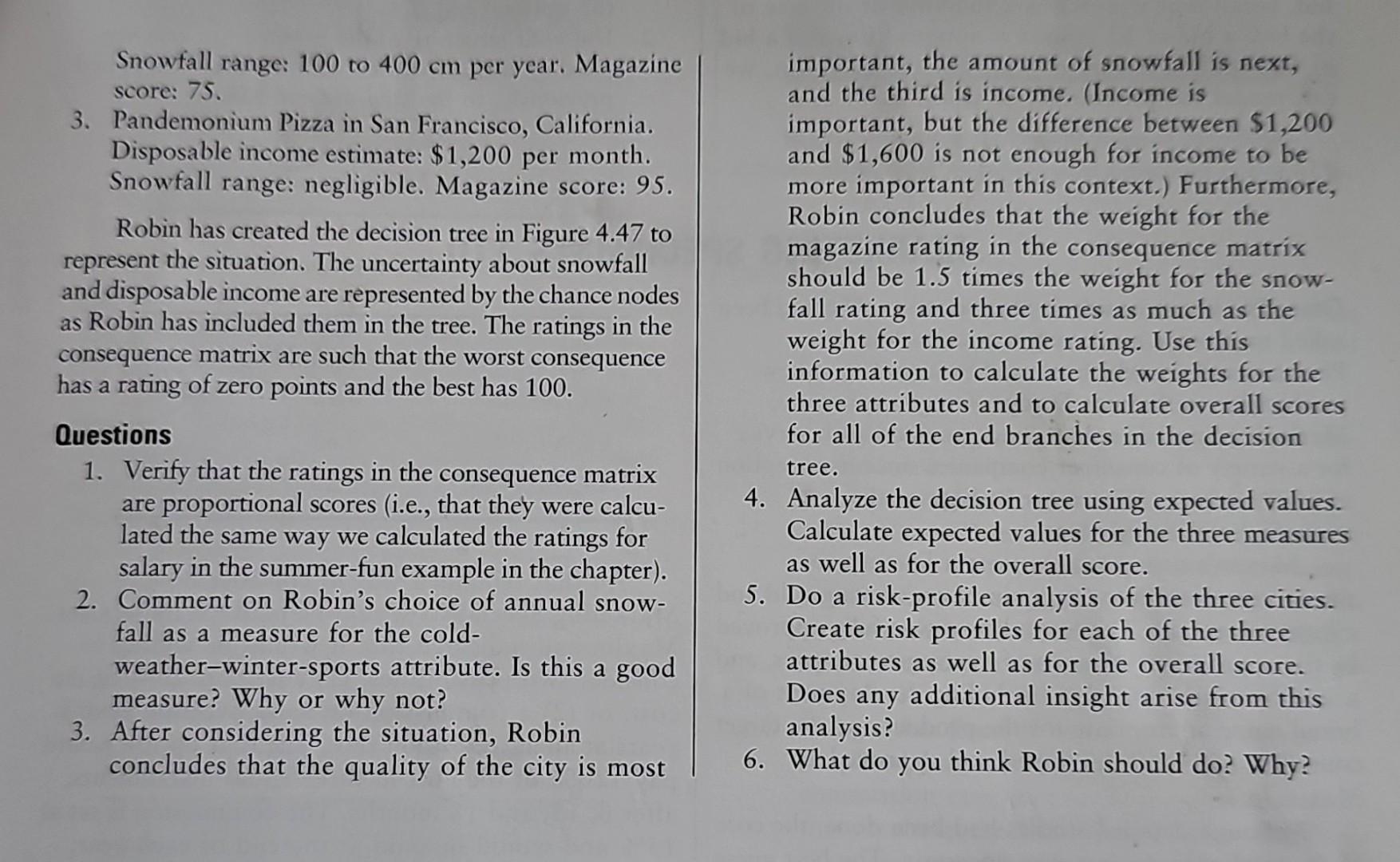
Case Studies 173 Lase studies 173 JOB OFFERS Robin Pinelli is considering three job offers. In trying to decide which to accept, Robin has concluded that three objectives are important in this decision. First, of course, is to maximize disposable income-the amount left after paying for housing, utilities, taxes, and other necessities. Second, Robin wants to spend more time in cold weather climates enjoying winter sports. The third objective relates to the quality of the community. Being single, Robin would like to live in a city with a lot of activities and a large population of single professionals. Developing attributes for these three objectives turns out to be relatively straightforward. Disposable income can be measured directly by calculating monthly takehome pay minus average monthly rent (being careful to include utilities) for an appropriate apartment. The second attribute is annual snowfall. For the third attribute, Robin has located a magazine survey of large cities that scores those cities as places for single professionals to live. Although the survey is not perfect from Robin's point of view, it does capture the main elements of her concern about the quality of the singles community and available activities. Also, all three of the cities under consideration are included in the survey. Here are descriptions of the three job offers: 1. MPR Manufacturing in Flagstaff, Arizona. Disposable income estimate: $1,600 per month. Snowfall range: 150 to 320cm per year. Magazine score: 50 (out of 100). 2. Madison Publishing in St. Paul, Minnesota. Disposable income estimate: $1,300 to $1,500 per month. (The uncertainty here is because Robin knows there is a wide variety in apartment rental prices and will not know what is appropriate and available until spending some time in the city.) JOB OFFERS Robin Pinelli is considering three job offers. In trying to decide which to accept, Robin has concluded that three objectives are important in this decision. First, of course, is to maximize disposable income-the amount left after paying for housing, utilities, taxes, and other necessities. Second, Robin wants to spend more time in cold weather climates enjoying winter sports. The third objective relates to the quality of the community. Being single, Robin would like to live in a city with a lot of activities and a large population of single professionals. Developing attributes for these three objectives turns out to be relatively straightforward. Disposable income can be measured directly by calculating monthly takehome pay minus average monthly rent (being careful to include utilities) for an appropriate apartment. The second attribute is annual snowfall. For the third attribute, Robin has located a magazine survey of large cities that scores those cities as places for single professionals to live. Although the survey is not perfect from Robin's point of view, it does capture the main elements of her concern about the quality of the singles community and available activities. Also, all three of the cities under consideration are included in the survey. Here are descriptions of the three job offers: 1. MPR Manufacturing in Flagstaff, Arizona. Disposable income estimate: $1,600 per month. Snowfall range: 150 to 320cm per year. Magazine score: 50 (out of 100). 2. Madison Publishing in St. Paul, Minnesota. Disposable income estimate: $1,300 to $1,500 per month. (The uncertainty here is because Robin knows there is a wide variety in apartment rental prices and will not know what is appropriate and available until spending some time in the city.) Snowfall range: 100 to 400cm per year. Magazine score: 75 . 3. Pandemonium Pizza in San Francisco, California. Disposable income estimate: $1,200 per month. Snowfall range: negligible. Magazine score: 95. Robin has created the decision tree in Figure 4.47 to represent the situation. The uncertainty about snowfall and disposable income are represented by the chance nodes as Robin has included them in the tree. The ratings in the consequence matrix are such that the worst consequence has a rating of zero points and the best has 100 . Questions 1. Verify that the ratings in the consequence matrix are proportional scores (i.e., that they were calculated the same way we calculated the ratings for salary in the summer-fun example in the chapter). 2. Comment on Robin's choice of annual snowfall as a measure for the coldweather-winter-sports attribute. Is this a good measure? Why or why not? 3. After considering the situation, Robin concludes that the quality of the city is most important, the amount of snowfall is next, and the third is income. (Income is important, but the difference between $1,200 and $1,600 is not enough for income to be more important in this context.) Furthermore, Robin concludes that the weight for the magazine rating in the consequence matrix should be 1.5 times the weight for the snowfall rating and three times as much as the weight for the income rating. Use this information to calculate the weights for the three attributes and to calculate overall scores for all of the end branches in the decision tree. 4. Analyze the decision tree using expected values. Calculate expected values for the three measures as well as for the overall score. 5. Do a risk-profile analysis of the three cities. Create risk profiles for each of the three attributes as well as for the overall score. Does any additional insight arise from this analysis? 6. What do you think Robin should do? Why? Snowfall range: 100 to 400cm per year. Magazine score: 75. 3. Pandemonium Pizza in San Francisco, California. Disposable income estimate: $1,200 per month. Snowfall range: negligible. Magazine score: 95. Robin has created the decision tree in Figure 4.47 to represent the situation. The uncertainty about snowfall and disposable income are represented by the chance nodes as Robin has included them in the tree. The ratings in the consequence matrix are such that the worst consequence has a rating of zero points and the best has 100 . Questions 1. Verify that the ratings in the consequence matrix are proportional scores (i.e., that they were calculated the same way we calculated the ratings for salary in the summer-fun example in the chapter). 2. Comment on Robin's choice of annual snowfall as a measure for the coldweather-winter-sports attribute. Is this a good measure? Why or why not? 3. After considering the situation, Robin concludes that the quality of the city is most important, the amount of snowfall is next, and the third is income. (Income is important, but the difference between $1,200 and $1,600 is not enough for income to be more important in this context.) Furthermore, Robin concludes that the weight for the magazine rating in the consequence matrix should be 1.5 times the weight for the snowfall rating and three times as much as the weight for the income rating. Use this information to calculate the weights for the three attributes and to calculate overall scores for all of the end branches in the decision tree. 4. Analyze the decision tree using expected values. Calculate expected values for the three measures as well as for the overall score. 5. Do a risk-profile analysis of the three cities. Create risk profiles for each of the three attributes as well as for the overall score. Does any additional insight arise from this analysis? 6. What do you think Robin should do? Why? Snowfall range: 100 to 400cm per year. Magazine score: 75 . 3. Pandemonium Pizza in San Francisco, California. Disposable income estimate: $1,200 per month. Snowfall range: negligible. Magazine score: 95. Robin has created the decision tree in Figure 4.47 to represent the situation. The uncertainty about snowfall and disposable income are represented by the chance nodes as Robin has included them in the tree. The ratings in the consequence matrix are such that the worst consequence has a rating of zero points and the best has 100 . Questions 1. Verify that the ratings in the consequence matrix are proportional scores (i.e., that they were calculated the same way we calculated the ratings for salary in the summer-fun example in the chapter). 2. Comment on Robin's choice of annual snowfall as a measure for the coldweather-winter-sports attribute. Is this a good measure? Why or why not? 3. After considering the situation, Robin concludes that the quality of the city is most important, the amount of snowfall is next, and the third is income. (Income is important, but the difference between $1,200 and $1,600 is not enough for income to be more important in this context.) Furthermore, Robin concludes that the weight for the magazine rating in the consequence matrix should be 1.5 times the weight for the snowfall rating and three times as much as the weight for the income rating. Use this information to calculate the weights for the three attributes and to calculate overall scores for all of the end branches in the decision tree. 4. Analyze the decision tree using expected values. Calculate expected values for the three measures as well as for the overall score. 5. Do a risk-profile analysis of the three cities. Create risk profiles for each of the three attributes as well as for the overall score. Does any additional insight arise from this analysis? 6. What do you think Robin should do? Why? JOB OFFERS bin Pinelli is considering three job offers. In ing to decide which to accept, Robin has ncluded that three objectives are important in this cision. First, of course, is to maximize disposable ome-the amount left after paying for housing, lities, taxes, and other necessities. Second, Robin nts to spend more time in cold weather climates oying winter sports. The third objective relates to quality of the community. Being single, Robin ald like to live in a city with a lot of activities a large population of single professionals. Developing attributes for these three objectives is out to be relatively straightforward. Disposable income can be measured directly by ulating monthly takehome pay minus average thly rent (being careful to include utilities) for an opriate apartment. The second attribute is annual fall. For the third attribute, Robin has located a magazine survey of large cities that scores those cities as places for single professionals to live. Although the survey is not perfect from Robin's point of view, it does capture the main elements of her concern about the quality of the singles community and available activities. Also, all three of the cities under consideration are included in the survey. Here are descriptions of the three job offers: 1. MPR Manufacturing in Flagstaff, Arizona. Disposable income estimate: $1,600 per month. Snowfall range: 150 to 320cm per year. Magazine score: 50 (out of 100). 2. Madison Publishing in St. Paul, Minnesota. Disposable income estimate: $1,300 to $1,500 per month. (The uncertainty here is because Robin knows there is a wide variety in apartment rental prices and will not know what is appropriate and available until spending some time in the city
Step by Step Solution
There are 3 Steps involved in it
Step: 1

Get Instant Access to Expert-Tailored Solutions
See step-by-step solutions with expert insights and AI powered tools for academic success
Step: 2

Step: 3

Ace Your Homework with AI
Get the answers you need in no time with our AI-driven, step-by-step assistance
Get Started


